Managing Technology Transfer Challenges in the Renewable Energy Sector within the European Union
Abstract
1. Introduction
2. The European Context
2.1. Negotiations on Climate Change and the Future of the Climate Change Issues
2.2. Current Trends in the Technology Transfer of Renewable Energy Technologies
2.3. Current Trends in Intellectual Property in Renewable Energy Technologies
3. Economic Background of Energy Implementation and Promotion of Renewable Energies
3.1. Challenges Linked with Electricity Grids
3.1.1. System Integration
3.1.2. Regulatory BARRIER
3.1.3. Maturity and Security of Technology and Supply Quality
3.1.4. Grids Operating at Full Capacity
3.1.5. The Remote Location of Renewable Power Plants
3.2. Challenges Linked with Fuel Transportation
3.3. The Role of Tax-Payers Money in the R&D of Renewable Energy
4. Solar and Photo-Voltaics
4.1. The Technology
4.2. Technology Transfer and IPR Challenges
4.3. Discussion on the Ramifications for the European Union
5. Biomass and Bioenergy
5.1. The Technology (Including 1st, 2nd, and 3rd Generation)
5.2. Technology Transfer and IPR Challenges
5.3. Discussion on the Ramifications for the European Union
6. Wind Energy
6.1. The Technology
6.2. Technology Transfer and IPR Challenges
6.3. Discussion on the Ramifications for the European Union
7. Marine Renewable Energy
7.1. The Technology
7.2. Technology Transfer and IPR Challenges
7.3. Discussion on the Ramifications for the European Union
8. Conclusions and Overall Implications
Author Contributions
Funding
Institutional Review Board Statement
Informed Consent Statement
Conflicts of Interest
References
- Ockwell, D.G.; Haum, R.; Mallett, A.; Watson, J. Intellectual property rights and low carbon technology transfer: Conflicting discourses of diffusion and development. Glob. Environ. Chang. 2010, 20, 729–738. [Google Scholar] [CrossRef]
- Johansson, T.B.; Turkenburg, W. Policies for renewable energy in the European Union and its member states: An overview. Energy Sustain. Dev. 2004, 8, 5–24. [Google Scholar] [CrossRef]
- Ellabban, O.; Abu-Rub, H.; Blaabjerg, F. Renewable energy resources: Current status, future prospects and their enabling technology. Renew. Sustain. Energy Rev. 2014, 39, 748–764. [Google Scholar] [CrossRef]
- Lewis, J.I. Managing intellectual property rights in cross-border clean energy collaboration: The case of the US--China Clean Energy Research Center. Energy Policy 2014, 69, 546–554. [Google Scholar] [CrossRef]
- Chandel, S.S.; Shrivastva, R.; Sharma, V.; Ramasamy, P. Overview of the initiatives in renewable energy sector under the national action plan on climate change in India. Renew. Sustain. Energy Rev. 2016, 54, 866–873. [Google Scholar] [CrossRef]
- del Río, P.; Peñasco, C.; Mir-Artigues, P. An overview of drivers and barriers to concentrated solar power in the European Union. Renew. Sustain. Energy Rev. 2018, 81, 1019–1029. [Google Scholar] [CrossRef]
- Edmonds, I. Fuel and emission reduction in deep open cut mining by replacing haul trucks with balloon-supported winches. Sustain. Energy Technol. Assess. 2020, 37, 100575. [Google Scholar] [CrossRef]
- Sen, S.; Ganguly, S. Opportunities, barriers and issues with renewable energy development—A discussion. Renew. Sustain. Energy Rev. 2017, 69, 1170–1181. [Google Scholar] [CrossRef]
- Espa, I.; Holzer, K. Negotiating 21st Century Rules on Energy: What Is at Stake for the European Union, the United States and the BRICS? J. World Investig. Trade 2018, 19, 415–443. [Google Scholar] [CrossRef]
- Urban, F. China’s rise: Challenging the North-South technology transfer paradigm for climate change mitigation and low carbon energy. Energy Policy 2018, 113, 320–330. [Google Scholar] [CrossRef]
- Malkin, A. The made in China challenge to US structural power: Industrial policy, intellectual property and multinational corporations. Rev. Int. Political Econ. 2020, 1–33. [Google Scholar] [CrossRef]
- Ferreira, J.J.M.; Fernandes, C.; Ratten, V. The effects of technology transfers and institutional factors on economic growth: Evidence from Europe and Oceania. J. Technol. Transf. 2019, 44, 1505–1528. [Google Scholar] [CrossRef]
- Ferreira, J.J.M.; Fernandes, C.I.; and Ferreira, F.A.F. Technology transfer, climate change mitigation, and environmental patent impact on sustainability and economic growth: A comparison of European countries. Technol. Forecast. Soc. Chang. 2020, 150, 119770. [Google Scholar] [CrossRef]
- Malhotra, A.; Schmidt, T.S.; Huenteler, J. The role of inter-sectoral learning in knowledge development and diffusion: Case studies on three clean energy technologies. Technol. Forecast. Soc. Chang. 2019, 146, 464–487. [Google Scholar] [CrossRef]
- Zhang, F.; Gallagher, K.S. Innovation and technology transfer through global value chains: Evidence from China’s PV industry. Energy Policy 2016, 94, 191–203. [Google Scholar] [CrossRef]
- Carbajo, R.; Cabeza, L.F. Renewable energy research and technologies through responsible research and innovation looking glass: Reflexions, theoretical approaches and contemporary discourses. Appl. Energy 2018, 211, 792–808. [Google Scholar] [CrossRef]
- Andoni, M.; Robu, V.; Flynn, D.; Abram, S.; Geach, D.; Jenkins, D.; McCallum, P.; Peacock, A. Blockchain technology in the energy sector: A systematic review of challenges and opportunities. Renew. Sustain. Energy Rev. 2019, 100, 143–174. [Google Scholar] [CrossRef]
- Oh, C. Discursive Contestation on Technological Innovation and the Institutional Design of the UNFCCC in the New Climate Change Regime. New Political Econ. 2020, 25, 660–674. [Google Scholar] [CrossRef]
- Chaiyapa, W.; Esteban, M.; Kameyama, Y. Why go green? Discourse analysis of motivations for Thailand’s oil and gas companies to invest in renewable energy. Energy Policy 2018, 120, 448–459. [Google Scholar] [CrossRef]
- Goel, M. Solar rooftop in India: Policies, challenges and outlook. Green Energy Environ. 2016, 1, 129–137. [Google Scholar] [CrossRef]
- Horbach, J.; Rammer, C. Energy transition in Germany and regional spill-overs: The diffusion of renewable energy in firms. Energy Policy 2018, 121, 404–414. [Google Scholar] [CrossRef]
- Hussain, A.; Arif, S.M.; Aslam, M. Emerging renewable and sustainable energy technologies: State of the art. Renew. Sustain. Energy Rev. 2017, 71, 12–28. [Google Scholar] [CrossRef]
- Thapar, S.; Sharma, S.; Verma, A. Economic and environmental effectiveness of renewable energy policy instruments: Best practices from India. Renew. Sustain. Energy Rev. 2016, 66, 487–498. [Google Scholar] [CrossRef]
- Ćetković, S.; Buzogány, A. Varieties of capitalism and clean energy transitions in the European Union: When renewable energy hits different economic logics. Clim. Policy 2016, 16, 642–657. [Google Scholar] [CrossRef]
- Hirsch, A.; Parag, Y.; Guerrero, J. Microgrids: A review of technologies, key drivers, and outstanding issues. Renew. Sustain. Energy Rev. 2018, 90, 402–411. [Google Scholar] [CrossRef]
- Gao, Y. China’s response to climate change issues after Paris Climate Change Conference. Adv. Clim. Chang. Res. 2016, 7, 235–240. [Google Scholar] [CrossRef]
- Wunderlich, U.-J. Positioning as Normative Actors: China and the EU in Climate Change Negotiations. JCMS: J. Common Mark. Stud. 2020, 58, 1107–1123. [Google Scholar] [CrossRef]
- Fernández, Y.F.; López, M.A.F.; Blanco, B.O. Innovation for sustainability: The impact of R&D spending on CO2 emissions. J. Clean. Prod. 2018, 172, 3459–3467. [Google Scholar]
- Maltby, T. European Union energy policy integration: A case of European Commission policy entrepreneurship and increasing supranationalism. Energy Policy 2013, 55, 435–444. [Google Scholar] [CrossRef]
- Dovie, D.B.K.; Lwasa, S. Correlating negotiation hotspot issues, Paris climate agreement and the international climate policy regime. Environ. Sci. Policy 2017, 77, 1–8. [Google Scholar] [CrossRef]
- Oberthür, S.; Groen, L. Explaining goal achievement in international negotiations: The EU and the Paris Agreement on climate change. J. Eur. Public Policy 2018, 25, 708–727. [Google Scholar] [CrossRef]
- Cucchiella, F.; D’Adamo, I.; Gastaldi, M.; Miliacca, M. Efficiency and allocation of emission allowances and energy consumption over more sustainable European economies. J. Clean. Prod. 2018, 182, 805–817. [Google Scholar] [CrossRef]
- Olmstead, S.M.; Stavins, R.N. Three key elements of a post-2012 international climate policy architecture. Rev. Environ. Econ. Policy 2012, 6, 65–85. [Google Scholar] [CrossRef]
- Rusu, M. Social Cost of Carbon: Opportunities and Environmental Solutions. Procedia Econ. Financ. 2012, 3, 690–697. [Google Scholar] [CrossRef][Green Version]
- Vatalis, K.I.; Laaksonen, A.; Charalampides, G.; Benetis, N.P. Intermediate technologies towards low-carbon economy. The Greek zeolite CCS outlook into the EU commitments. Renew. Sustain. Energy Rev. 2012, 16, 3391–3400. [Google Scholar] [CrossRef]
- Wei, M.Y.; Zou, L.-L.; Wang, K.; Yi, W.-J.; Wang, L. Review of proposals for an Agreement on Future Climate Policy: Perspectives from the responsibilities for GHG reduction. Energy Strategy Rev. 2013, 2, 161–168. [Google Scholar] [CrossRef]
- Kijewska, A.; Bluszcz, A. Analysis of greenhouse gas emissions in the European Union member states with the use of an agglomeration algorithm. J. Sustain. Min. 2016, 15, 133–142. [Google Scholar] [CrossRef]
- Liobikien, G.; Butkus, M. The European Union possibilities to achieve targets of Europe 2020 and Paris agreement climate policy. Renew. Energy 2017, 106, 298–309. [Google Scholar] [CrossRef]
- Roos, I.; Soosaar, S.; Volkova, A.; Streimikene, D. Greenhouse gas emission reduction perspectives in the Baltic States in frames of EU energy and climate policy. Renew. Sustain. Energy Rev. 2012, 16, 2133–2146. [Google Scholar] [CrossRef]
- Streimikiene, D. The impact of international GHG trading regimes on penetration of new energy technologies and feasibility to implement EU Energy and Climate Package targets. Renew. Sustain. Energy Rev. 2012, 16, 2172–2177. [Google Scholar] [CrossRef]
- Bäckstrand, K.; Kuyper, J.W.; Linnér, B.-O.; Lövbrand, E. Non-state actors in global climate governance: From Copenhagen to Paris and beyond. Environ. Politics 2017, 26, 561–579. [Google Scholar] [CrossRef]
- Caparrós, A.; Péreau, J.-C. Multilateral versus sequential negotiations over climate change. Oxf. Econ. Pap. 2017, 69, 365–387. [Google Scholar] [CrossRef]
- Carlini, E.M.; Schroeder, R.; Birkebæk, J.M.; Massaro, F. EU transition in power sector: How RES affects the design and operations of transmission power systems. Electr. Power Syst. Res. 2019, 169, 74–91. [Google Scholar] [CrossRef]
- Hajer, M.A.; Pelzer, P. 2050—An Energetic Odyssey: Understanding ‘Techniques of Futuring’in the transition towards renewable energy. Energy Res. Soc. Sci. 2018, 44, 222–231. [Google Scholar] [CrossRef]
- Malinauskaite, J.; Jouhara, H.; Ahmad, L.; Milani, M.; Montorsi, L.; Venturelli, M. Energy efficiency in industry: EU and national policies in Italy and the UK. Energy 2019, 172, 255–269. [Google Scholar] [CrossRef]
- Ringel, M.; Knodt, M. The governance of the European Energy Union: Efficiency, effectiveness and acceptance of the Winter Package 2016. Energy Policy 2018, 112, 209–220. [Google Scholar] [CrossRef]
- Liu, H.; Subramanian, A.M.; Hang, C. Marrying the Best of Both Worlds: An Integrated Framework for Matching Technology Transfer Sources and Recipients. IEEE Trans. Eng. Manag. 2020, 67, 70–80. [Google Scholar] [CrossRef]
- Anderson, A.; Rezaie, B. Geothermal technology: Trends and potential role in a sustainable future. Appl. Energy 2019, 248, 18–34. [Google Scholar] [CrossRef]
- Xu, X.; Wei, Z.; Ji, Q.; Wang, C.; Gao, G. Global renewable energy development: Influencing factors, trend predictions and countermeasures. Resour. Policy 2019, 63, 101470. [Google Scholar] [CrossRef]
- Child, M.; Kemfert, C.; Bogdanov, D.; Breyer, C. Flexible electricity generation, grid exchange and storage for the transition to a 100% renewable energy system in Europe. Renew. Energy 2019, 139, 80–101. [Google Scholar] [CrossRef]
- Sahota, S.; Shah, G.; Ghosh, P.; Kapoor, R.; Sengupta, S.; Singh, P.; Vijay, V.; Sahay, A.; Vijay, V.K.; Thakur, I.S. Review of trends in biogas upgradation technologies and future perspectives. Bioresour. Technol. Rep. 2018, 1, 79–88. [Google Scholar] [CrossRef]
- Segura, E.; Morales, R.; Somolinos, J.A.; López, A. Techno-economic challenges of tidal energy conversion systems: Current status and trends. Renew. Sustain. Energy Rev. 2017, 77, 536–550. [Google Scholar] [CrossRef]
- Bai, C.; Feng, C.; Yan, H.; Yi, X.; Chen, Z.; Wei, W. Will income inequality influence the abatement effect of renewable energy technological innovation on carbon dioxide emissions? J. Environ. Manag. 2020, 264, 110482. [Google Scholar] [CrossRef] [PubMed]
- Roud, V.; Vlasova, V. Strategies of industry-science cooperation in the Russian manufacturing sector. J. Technol. Transf. 2020, 45, 870–907. [Google Scholar] [CrossRef]
- Foray, D.; Woerter, M. The formation of Coasean institutions to provide university knowledge for innovation: A case study and econometric evidence for Switzerland. J. Technol. Transf. 2020, 46, 1584–1610. [Google Scholar] [CrossRef]
- Corsi, A.; Pagani, R.N.; Kovaleski, J.L.; Luiz da Silva, V. Technology transfer for sustainable development: Social impacts depicted and some other answers to a few questions. J. Clean. Prod. 2020, 245, 118522. [Google Scholar] [CrossRef]
- Rudyk, I. European Patent Office Data. 2018. Available online: https://docs.google.com/viewer?url=https%3A%2F%2Fwww.irena.org%2F-%2Fmedia%2FFiles%2FIRENA%2FAgency%2FEvents%2F2018%2FOct%2FIP-Conference%2F1_EPO_Patents-and-CCMT_Bocconi_Ilja-Rudyk.pdf%3Fla%3Den%26hash%3DB93E902335BD978BA25207C2F1716ED04D0D1AFD (accessed on 1 November 2021).
- Benasla, M.; Hess, D.; Allaoui, T.; Brahami, M.; Dena, M. The transition towards a sustainable energy system in Europe: What role can North Africa’s solar resources play? Energy Strategy Rev. 2019, 24, 1–13. [Google Scholar] [CrossRef]
- Eurostat. EuroStat Gross Available Energy in the EU from 1990 to 2019. Available online: https://ec.europa.eu/eurostat/statistics-explained/index.php?title=Energy_statistics_-_an_overview (accessed on 4 October 2021).
- Eurostat. Renewable Energy Share in the EU by Member States. Available online: https://ec.europa.eu/eurostat/documents/2995521/9571695/8-12022019-AP-EN.pdf/b7d237c1-ccea-4adc-a0ba-45e13602b428 (accessed on 23 October 2021).
- Grafström, J. Divergence of renewable energy invention efforts in Europe: An econometric analysis based on patent counts. Environ. Econ. Policy Stud. 2018, 20, 829–859. [Google Scholar] [CrossRef]
- Bonnet, C.; Carcanague, S.; Hache, E.; Seck, G.; Simoën, M. The Nexus between Climate Negotiations and Low-Carbon Innovation: A Geopolitics of Renewable Energy Patents; EconomiX-UMR7235; Université Paris Nanterre: Nanterre, France, 2018. [Google Scholar]
- Strandberg, J.; Bergors, L.; Forkamp, U.; Lindblom, E.; Knutsson, S.; Nakamura, A.; Brundin, J. Företag Inom Miljötekniksektorn 2007–2011; Vinnova: Stockholm, Sweden, 2013. [Google Scholar]
- Dehghani Madvar, M.; Aslani, A.; Ahmadi, M.H.; Karbalaie Ghomi, N.S. Current status and future forecasting of biofuels technology development. Int. J. Energy Res. 2019, 43, 1142–1160. [Google Scholar] [CrossRef]
- Lacal-Arántegui, R. Globalization in the wind energy industry: Contribution and economic impact of European companies. Renew. Energy 2019, 134, 612–628. [Google Scholar] [CrossRef]
- Pitelis, A.; Vasilakos, N.; Chalvatzis, K. Fostering innovation in renewable energy technologies: Choice of policy instruments and effectiveness. Renew. Energy 2020, 151, 1163–1172. [Google Scholar] [CrossRef]
- Saint Akadiri, S.; Alola, A.A.; Akadiri, A.C.; Alola, U.V. Renewable energy consumption in EU-28 countries: Policy toward pollution mitigation and economic sustainability. Energy Policy 2019, 132, 803–810. [Google Scholar] [CrossRef]
- Lin, B.; Zhu, J. The role of renewable energy technological innovation on climate change: Empirical evidence from China. Sci. Total Environ. 2019, 659, 1505–1512. [Google Scholar] [CrossRef]
- Yan, J.; Kuang, Y.; Gui, X.; Han, X.; Yan, Y. Engineering a malic enzyme to enhance lipid accumulation in Chlorella protothecoides and direct production of biodiesel from the microalgal biomass. Biomass Bioenergy 2019, 122, 298–304. [Google Scholar] [CrossRef]
- Azam, A.; Rafiq, M.; Shafique, M.; Zhang, H.; Ateeq, M.; Yuan, J. Analyzing the relationship between economic growth and electricity consumption from renewable and non-renewable sources: Fresh evidence from newly industrialized countries. Sustain. Energy Technol. Assess. 2021, 44, 100991. [Google Scholar] [CrossRef]
- Yang, Y.; Ren, J.; Solgaard, H.S.; Xu, D.; Nguyen, T.T. Using multi-criteria analysis to prioritize renewable energy home heating technologies. Sustain. Energy Technol. Assess. 2018, 29, 36–43. [Google Scholar] [CrossRef]
- IqtiyaniIlham, N.; Hasanuzzaman, M.; Hosenuzzaman, M. European smart grid prospects, policies, and challenges. Renew. Sustain. Energy Rev. 2017, 67, 776–790. [Google Scholar] [CrossRef]
- Giordano, V.; Gangale, F.; Fulli, G.; Jiménez, M.S.; Onyeji, I.; Colta, A.; Papaioannou, I.; Mengolini, A.; Alecu, C.; Ojala, T.; et al. Smart Grid Projects in Europe: Lessons Learned And Current Developments; JRC Reference Reports; Publications Office of the European Union: Luxembourg, 2011. [Google Scholar]
- Ove Eikeland, P.; Birger Skjærseth, J. The politics of low-carbon innovation: Implementing the European Union’s strategic energy technology plan. Energy Res. Soc. Sci. 2021, 76, 102043. [Google Scholar] [CrossRef]
- Kalantaridis, C.; Küttim, M. University ownership and information about the entrepreneurial opportunity in commercialisation: A systematic review and realist synthesis of the literature. J. Technol. Transf. 2020, 46, 1487–1513. [Google Scholar] [CrossRef]
- Cebulla, F.; Naegler, T.; Pohl, M. Electrical energy storage in highly renewable European energy systems: Capacity requirements, spatial distribution, and storage dispatch. J. Energy Storage 2017, 14, 211–223. [Google Scholar] [CrossRef]
- Müller, M.; Viernstein, L.; Truong, C.N.; Eiting, A.; Hesse, H.C.; Witzmann, R.; Jossen, A. Evaluation of grid-level adaptability for stationary battery energy storage system applications in Europe. J. Energy Storage 2017, 9, 1–11. [Google Scholar] [CrossRef]
- Rouzbehi, K.; Candela, J.I.; Gharehpetian, G.B.; Harnefors, L.; Luna, A.; Rodriguez, P. Multiterminal DC grids: Operating analogies to AC power systems. Renew. Sustain. Energy Rev. 2017, 70, 886–895. [Google Scholar] [CrossRef]
- Radu, D.; Berger, M.; Fonteneau, R.; Hardy, S.; Fettweis, X.; Le Du, M.; Panciatici, P.; Balea, L.; Ernst, D. Complementarity assessment of south Greenland katabatic flows and West Europe wind regimes. Energy 2019, 175, 393–401. [Google Scholar] [CrossRef]
- Purvins, A.; Sereno, L.; Ardelean, M.; Covrig, C.-F.; Efthimiadis, T.; Minnebo, P. Submarine power cable between Europe and North America: A techno-economic analysis. J. Clean. Prod. 2018, 186, 131–145. [Google Scholar] [CrossRef]
- Krook-Riekkola, A.; Berg, C.; Ahlgren, E.O.; Söderholm, P. Challenges in top-down and bottom-up soft-linking: Lessons from linking a Swedish energy system model with a CGE model. Energy 2017, 141, 803–817. [Google Scholar] [CrossRef]
- Darda, S.; Papalas, T.; Zabaniotou, A. Biofuels journey in Europe: Currently the way to low carbon economy sustainability is still a challenge. J. Clean. Prod. 2019, 208, 575–588. [Google Scholar] [CrossRef]
- Kern, F.; Kivimaa, P.; Martiskainen, M. Policy packaging or policy patching? The development of complex energy efficiency policy mixes. Energy Res. Soc. Sci. 2017, 23, 11–25. [Google Scholar] [CrossRef]
- Urbano, D.; Guerrero, M.; Ferreira, J.J.; Fernandes, C.I. New technology entrepreneurship initiatives: Which strategic orientations and environmental conditions matter in the new socio-economic landscape? J. Technol. Transf. 2019, 44, 1577–1602. [Google Scholar] [CrossRef]
- Herman, K.S.; Xiang, J. Environmental regulatory spillovers, institutions, and clean technology innovation: A panel of 32 countries over 16 years. Energy Res. Soc. Sci. 2020, 62, 101363. [Google Scholar] [CrossRef]
- Yang, X.; He, L.; Xia, Y.; Chen, Y. Effect of government subsidies on renewable energy investments: The threshold effect. Energy Policy 2019, 132, 156–166. [Google Scholar] [CrossRef]
- Hills, J.M.; Michalena, E. Renewable energy pioneers are threatened by EU policy reform. Renew. Energy 2017, 108, 26–36. [Google Scholar] [CrossRef]
- Dvořák, P.; Martinát, S.; Van der Horst, D.; Frantál, B.; Turečková, K. Renewable energy investment and job creation; a cross-sectoral assessment for the Czech Republic with reference to EU benchmarks. Renew. Sustain. Energy Rev. 2017, 69, 360–368. [Google Scholar] [CrossRef]
- Oliveira, C.; Coelho, D.; Pereira da Silva, P.; Antunes, C.H. How many jobs can the RES-E sectors generate in the Portuguese context? Renew. Sustain. Energy Rev. 2013, 21, 444–455. [Google Scholar] [CrossRef]
- Pardo García, N.; Zubi, G.; Pasaoglu, G.; Dufo-López, R. Photovoltaic thermal hybrid solar collector and district heating configurations for a Central European multi-family house. Energy Convers. Manag. 2017, 148, 915–924. [Google Scholar] [CrossRef]
- Jamil, E.; Hameed, S.; Jamil, B.; Qurratulain. Power quality improvement of distribution system with photovoltaic and permanent magnet synchronous generator based renewable energy farm using static synchronous compensator. Sustain. Energy Technol. Assess. 2019, 35, 98–116. [Google Scholar] [CrossRef]
- Lehtola, T.; Zahedi, A. Solar energy and wind power supply supported by storage technology: A review. Sustain. Energy Technol. Assess. 2019, 35, 25–31. [Google Scholar] [CrossRef]
- Li, Y.; Wu, J. Optimum Integration of Solar Energy With Battery Energy Storage Systems. IEEE Trans. Eng. Manag. 2020, 69, 697–707. [Google Scholar] [CrossRef]
- Shubbak, M.H. Advances in solar photovoltaics: Technology review and patent trends. Renew. Sustain. Energy Rev. 2019, 115, 109383. [Google Scholar] [CrossRef]
- Salim, H.K.; Stewart, R.A.; Sahin, O.; Dudley, M. Drivers, barriers and enablers to end-of-life management of solar photovoltaic and battery energy storage systems: A systematic literature review. J. Clean. Prod. 2019, 211, 537–554. [Google Scholar] [CrossRef]
- Prentice, G.S.K.; Brent, A.C.; de Kock, I.H. A Strategic Management Framework for the Commercialization of Multitechnology Renewable Energy Systems: The Case of Concentrating Solar Power in South Africa. IEEE Trans. Eng. Manag. 2020, 68, 1690–1702. [Google Scholar] [CrossRef]
- Frank, S.; Böttcher, H.; Gusti, M.; Havlík, P.; Klaassen, G.; Kindermann, G.; Obersteiner, M. Dynamics of the land use, land use change, and forestry sink in the European Union: The impacts of energy and climate targets for 2030. Clim. Chang. 2016, 138, 253–266. [Google Scholar] [CrossRef]
- Abdel-Latif, A. Intellectual property rights and the transfer of climate change technologies: Issues, challenges, and way forward. Clim. Policy 2015, 15, 103–126. [Google Scholar] [CrossRef]
- Brenner, W.; Adamovic, N. Standardization as a tool for promoting innovation and commercialization of a circular economy for PV waste—The example of the European H2020 project CABRISS. In Proceedings of the 2018 41st International Convention on Information and Communication Technology, Electronics and Microelectronics (MIPRO), Opatija, Croatia, 21–25 May 2018; pp. 122–127. [Google Scholar] [CrossRef]
- Laajimi, M.; Go, Y.I. Energy storage system design for large-scale solar PV in Malaysia: Techno-economic analysis. Renew. Wind Water Sol. 2021, 8, 3. [Google Scholar] [CrossRef]
- Pigato, M.A.; Black, S.J.; Dussaux, D.; Mao, Z.; McKenna, M.; Rafaty, R.; Touboul, S.A. Framework for Low-Carbon Technology Transfer. In Technology Transfer and Innovation for Low-Carbon Development; World Bank Group: Washington, DC, USA; pp. 1–25. [CrossRef]
- Glachant, M.; Dechezleprêtre, A. What role for climate negotiations on technology transfer? Clim. Policy 2017, 17, 962–981. [Google Scholar] [CrossRef]
- Hrga, A.; Capuder, T.; Žarko, I.P. Demystifying Distributed Ledger Technologies: Limits, Challenges, and Potentials in the Energy Sector. IEEE Access 2020, 8, 126149–126163. [Google Scholar] [CrossRef]
- Fernand, F.; Israel, A.; Skjermo, J.; Wichard, T.; Timmermans, K.R.; Golberg, A. Offshore macroalgae biomass for bioenergy production: Environmental aspects, technological achievements and challenges. Renew. Sustain. Energy Rev. 2017, 75, 35–45. [Google Scholar] [CrossRef]
- Kheybari, S.; Rezaie, F.M.; Rezaei, J. Measuring the Importance of Decision-Making Criteria in Biofuel Production Technology Selection. IEEE Trans. Eng. Manag. 2021, 68, 483–497. [Google Scholar] [CrossRef]
- van Holsbeeck, S.; Srivastava, S.K. Feasibility of locating biomass-to-bioenergy conversion facilities using spatial information technologies: A case study on forest biomass in Queensland, Australia. Biomass Bioenergy 2020, 139, 105620. [Google Scholar] [CrossRef]
- Lee, C.; Sun, W.; Li, Y. Biodiesel Economic Evaluation and Biomass Planting Allocation Optimization in Global Supply Chain. IEEE Trans. Eng. Manag. 2019, 69, 602–615. [Google Scholar] [CrossRef]
- Van Meerbeek, K.; Muys, B.; Hermy, M. Lignocellulosic biomass for bioenergy beyond intensive cropland and forests. Renew. Sustain. Energy Rev. 2019, 102, 139–149. [Google Scholar] [CrossRef]
- Gosens, J.; Hellsmark, H.; Kåberger, T.; Liu, L.; Sandén, B.A.; Wang, S.; Zhao, L. The limits of academic entrepreneurship: Conflicting expectations about commercialization and innovation in China’s nascent sector for advanced bio-energy technologies. Energy Res. Soc. Sci. 2018, 37, 1–11. [Google Scholar] [CrossRef]
- Maier, J.M.; Sowlati, T.; Salazar, J. Life cycle assessment of forest-based biomass for bioenergy: A case study in British Columbia, Canada. Resour. Conserv. Recycl. 2019, 146, 598–609. [Google Scholar] [CrossRef]
- Dalpaz, R.; Konrad, O.; Cândido da Silva Cyrne, C.; Panis Barzotto, H.; Hasan, C.; Guerini Filho, M. Using biogas for energy cogeneration: An analysis of electric and thermal energy generation from agro-industrial waste. Sustain. Energy Technol. Assess. 2020, 40, 100774. [Google Scholar] [CrossRef]
- Ozturk, M.; Saba, N.; Altay, V.; Iqbal, R.; Hakeem, K.R.; Jawaid, M.; Ibrahim, F.H. Biomass and bioenergy: An overview of the development potential in Turkey and Malaysia. Renew. Sustain. Energy Rev. 2017, 79, 1285–1302. [Google Scholar] [CrossRef]
- Welfle, A. Balancing growing global bioenergy resource demands-Brazil’s biomass potential and the availability of resource for trade. Biomass Bioenergy 2017, 105, 83–95. [Google Scholar] [CrossRef]
- Naik, S.N.; Goud, V.V.; Rout, P.K.; Dalai, A.K. Production of first and second generation biofuels: A comprehensive review. Renew. Sustain. Energy Rev. 2010, 14, 578–597. [Google Scholar] [CrossRef]
- Groen, L.; Niemann, A.; Oberthür, S. The EU’s Role in International Climate Change Policy-Making: A Global Leader in Decline? In Global Power Europe-Vol. 2; Springer: Berlin/Heidelberg, Germany, 2013; pp. 37–54. [Google Scholar]
- Nabuurs, G.J.; Arets, E.; Lesschen, J.P.; Schelhaas, M.J. Effects of the EU-LULUCF Regulation on the Use of Biomass for Bio-Energy. 2018. Available online: https://library.wur.nl/WebQuery/wurpubs/fulltext/449788 (accessed on 4 September 2021).
- Menegazzo, M.L.; Fonseca, G.G. Biomass recovery and lipid extraction processes for microalgae biofuels production: A review. Renew. Sustain. Energy Rev. 2019, 107, 87–107. [Google Scholar] [CrossRef]
- Zanetti, F.; Isbell, T.A.; Gesch, R.W.; Evangelista, R.L.; Alexopoulou, E.; Moser, B.; Monti, A. Turning a burden into an opportunity: Pennycress (Thlaspi arvense L.) a new oilseed crop for biofuel production. Biomass Bioenergy 2019, 130, 105354. [Google Scholar] [CrossRef]
- Lisboa, I.P.; Cherubin, M.R.; Satiro, L.S.; Siqueira-Neto, M.; Lima, R.; Gmach, M.R.; Wienhold, B.J.; Schmer, M.R.; Jin, V.L.; Cerri, C.E. Applying Soil Management Assessment Framework (SMAF) on short-term sugarcane straw removal in Brazil. Ind. Crops Prod. 2019, 129, 175–184. [Google Scholar] [CrossRef]
- Onarheim, K.; Hannula, I.; Solantausta, Y. Hydrogen enhanced biofuels for transport via fast pyrolysis of biomass: A conceptual assessment. Energy 2020, 199, 117337. [Google Scholar] [CrossRef]
- Ramaswamy, J.; Siddareddy Vemareddy, P. Production of biogas using small-scale plug flow reactor and sizing calculation for biodegradable solid waste. Renew. Wind Water Sol. 2015, 2, 6. [Google Scholar] [CrossRef]
- Dutta, A. Impact of carbon emission trading on the European Union biodiesel feedstock market. Biomass Bioenergy 2019, 128, 105328. [Google Scholar] [CrossRef]
- Beagle, E.; Belmont, E. Comparative life cycle assessment of biomass utilization for electricity generation in the European Union and the United States. Energy Policy 2019, 128, 267–275. [Google Scholar] [CrossRef]
- Saez de Bikuña, K.; Garcia, R.; Dias, A.C.; Freire, F. Global warming implications from increased forest biomass utilization for bioenergy in a supply-constrained context. J. Environ. Manag. 2020, 263, 110292. [Google Scholar] [CrossRef]
- Bórawski, P.; Bełdycka-Bórawska, A.; Szymańska, E.J.; Jankowski, K.J.; Dubis, B.; Dunn, J.W. Development of renewable energy sources market and biofuels in The European Union. J. Clean. Prod. 2019, 228, 467–484. [Google Scholar] [CrossRef]
- Sulaiman, C.; Abdul-Rahim, A.S.; Ofozor, C.A. Does wood biomass energy use reduce CO2 emissions in European Union member countries? Evidence from 27 members. J. Clean. Prod. 2020, 253, 119996. [Google Scholar] [CrossRef]
- Bento, N.; Fontes, M. Emergence of floating offshore wind energy: Technology and industry. Renew. Sustain. Energy Rev. 2019, 99, 66–82. [Google Scholar] [CrossRef]
- Østergaard, P.A.; Duic, N.; Noorollahi, Y.; Mikulcic, H.; Kalogirou, S. Sustainable development using renewable energy technology. Renew. Energy 2020, 146, 2430–2437. [Google Scholar] [CrossRef]
- Rosales-Asensio, E.; Borge-Diez, D.; Blanes-Peiró, J.-J.; Pérez-Hoyos, A.; Comenar-Santos, A. Review of wind energy technology and associated market and economic conditions in Spain. Renew. Sustain. Energy Rev. 2019, 101, 415–427. [Google Scholar] [CrossRef]
- González, J.S.; Lacal-Arántegui, R. A review of regulatory framework for wind energy in European Union countries: Current state and expected developments. Renew. Sustain. Energy Rev. 2016, 56, 588–602. [Google Scholar] [CrossRef]
- Michalak, P.; Zimny, J. Wind energy development in the world, Europe and Poland from 1995 to 2009; current status and future perspectives. Renew. Sustain. Energy Rev. 2011, 15, 2330–2341. [Google Scholar] [CrossRef]
- Evans, A.J.; Firth, L.B.; Hawkins, S.J.; Hall, A.E.; Ironside, J.E.; Thompson, R.C.; Moore, P.J. From ocean sprawl to blue-green infrastructure–A UK perspective on an issue of global significance. Environ. Sci. Policy 2019, 91, 60–69. [Google Scholar] [CrossRef]
- Enevoldsen, P.; Permien, F.-H.; Bakhtaoui, I.; von Krauland, A.-K.; Jacobson, M.Z.; Xydis, G.; Sovacool, B.K.; Valentine, S.V.; Luecht, D.; Oxley, G. How much wind power potential does europe have? Examining european wind power potential with an enhanced socio-technical atlas. Energy Policy 2019, 132, 1092–1100. [Google Scholar] [CrossRef]
- Howland, M.F.; Lele, S.K.; Dabiri, J.O. Wind farm power optimization through wake steering. Proc. Natl. Acad. Sci. USA 2019, 116, 14495–14500. [Google Scholar] [CrossRef]
- Charabi, Y.; Abdul-Wahab, S. Wind turbine performance analysis for energy cost minimization. Renew. Wind Water Sol. 2020, 7, 5. [Google Scholar] [CrossRef]
- Lei, M.; Zhang, J.; Dong, X.; Ye, J.J. Modeling the bids of wind power producers in the day-ahead market with stochastic market clearing. Sustain. Energy Technol. Assess. 2016, 16, 151–161. [Google Scholar] [CrossRef]
- Spro, O.C.; Torres-Olguin, R.E.; Korpås, M. North Sea offshore network and energy storage for large scale integration of renewables. Sustain. Energy Technol. Assess. 2015, 11, 142–147. [Google Scholar] [CrossRef]
- Urban, F.; Zhou, Y.; Nordensvard, J.; Narain, A. Firm-level technology transfer and technology cooperation for wind energy between Europe, China and India: From North–South to South–North cooperation? Energy Sustain. Dev. 2015, 28, 29–40. [Google Scholar] [CrossRef]
- Rogers, T.; Ashtine, M.; Koon Koon, R.; Atherley-Ikechi, M. Onshore wind energy potential for Small Island Developing States: Findings and recommendations from Barbados. Energy Sustain. Dev. 2019, 52, 116–127. [Google Scholar] [CrossRef]
- Haites, E.; Duan, M.; Seres, S. Technology transfer by CDM projects. Clim. Policy 2006, 6, 327–344. [Google Scholar] [CrossRef]
- Miyamoto, M.; Takeuchi, K. Climate agreement and technology diffusion: Impact of the Kyoto Protocol on international patent applications for renewable energy technologies. Energy Policy 2019, 129, 1331–1338. [Google Scholar] [CrossRef]
- BREWER, T.L. Climate change technology transfer: A new paradigm and policy agenda. Clim. Policy 2008, 8, 516–526. [Google Scholar] [CrossRef]
- Solman, H.; Smits, M.; van Vliet, B.; Bush, S. Co-production in the wind energy sector: A systematic literature review of public engagement beyond invited stakeholder participation. Energy Res. Soc. Sci. 2021, 72, 101876. [Google Scholar] [CrossRef]
- Karakosta, C.; Doukas, H.; Psarras, J. Technology transfer through climate change: Setting a sustainable energy pattern. Renew. Sustain. Energy Rev. 2010, 14, 1546–1557. [Google Scholar] [CrossRef]
- Gaddada, S.; Kodicherla, S.P.K. Wind energy potential and cost estimation of wind energy conversion systems (WECSs) for electricity generation in the eight selected locations of Tigray region (Ethiopia). Renew. Wind Water Sol. 2016, 3, 10. [Google Scholar] [CrossRef]
- Byrne, R.; Hewitt, N.J.; Griffiths, P.; MacArtain, P. Observed site obstacle impacts on the energy performance of a large scale urban wind turbine using an electrical energy rose. Energy Sustain. Dev. 2018, 43, 23–37. [Google Scholar] [CrossRef]
- Ma, Z.F. The effectiveness of Kyoto Protocol and the legal institution for international technology transfer. J. Technol. Transf. 2012, 37, 75–97. [Google Scholar] [CrossRef]
- Youngman, R.O.B.; Schmidt, J.; Lee, J.I.N.; de Coninck, H. Evaluating technology transfer in the Clean Development Mechanism and Joint Implementation. Clim. Policy 2007, 7, 488–499. [Google Scholar] [CrossRef]
- Dechezleprêtre, A.; Glachant, M.; Ménière, Y. What Drives the International Transfer of Climate Change Mitigation Technologies? Empirical Evidence from Patent Data. Environ. Resour. Econ. 2013, 54, 161–178. [Google Scholar] [CrossRef]
- Indo-German Economic Cooperation at a Glance. Available online: https://india.diplo.de/in-en/themen/bilateral-cooperation/1992794 (accessed on 5 June 2021).
- Bonnet, C.; Hache, E.; Seck, G.S.; Simoën, M.; Carcanague, S. Who’s winning the low-carbon innovation race? An assessment of countries’ leadership in renewable energy technologies. Int. Econ. 2019, 160, 31–42. [Google Scholar] [CrossRef]
- Bonenkamp, T.B.; Middelburg, L.M.; Hosli, M.O.; Wolffenbuttel, R.F. From bioethanol containing fuels towards a fuel economy that includes methanol derived from renewable sources and the impact on European Union decision-making on transition pathways. Renew. Sustain. Energy Rev. 2020, 120, 109667. [Google Scholar] [CrossRef]
- Anton, S.G.; Afloarei Nucu, A.E. The effect of financial development on renewable energy consumption. A panel data approach. Renew. Energy 2020, 147, 330–338. [Google Scholar] [CrossRef]
- Holland, D.; Young, G. The economic implications of climate change mitigation policies. Natl. Inst. Econ. Rev. 2020, 251, R1–R2. [Google Scholar] [CrossRef]
- Sood, M.; Singal, S.K. Development of hydrokinetic energy technology: A review. Int. J. Energy Res. 2019, 43, 5552–5571. [Google Scholar] [CrossRef]
- Wang, Z.; Carriveau, R.; Ting, D.S.-K.; Xiong, W.; Wang, Z. A review of marine renewable energy storage. Int. J. Energy Res. 2019, 43, 6108–6150. [Google Scholar] [CrossRef]
- Sim, J.; Kim, C.-S. The value of renewable energy research and development investments with default consideration. Renew. Energy 2019, 143, 530–539. [Google Scholar] [CrossRef]
- Wilberforce, T.; el Hassan, Z.; Durrant, A.; Thompson, J.; Soudan, B.; Olabi, A.G. Overview of ocean power technology. Energy 2019, 175, 165–181. [Google Scholar] [CrossRef]
- Green, R.; Copping, A.; Cavagnaro, R.J.; Rose, D.; Overhus, D.; Jenne, D. Enabling Power at Sea: Opportunities for Expanded Ocean Observations through Marine Renewable Energy Integration. In Proceedings of the OCEANS OCEANS 2019 Seattle, Seattle, WA, USA, 27–31 October 2019; pp. 1–7. [Google Scholar] [CrossRef]
- Zhou, Z.; Benbouzid, M.; Charpentier, J.-F.; Scuiller, F.; Tang, T. Developments in large marine current turbine technologies–A review. Renew. Sustain. Energy Rev. 2017, 71, 852–858. [Google Scholar] [CrossRef]
- Peters, M.A. Trade wars, technology transfer, and the future Chinese techno-state. Educ. Philos. Theory 2019, 51, 867–870. [Google Scholar] [CrossRef]
- de Almeida Borges, P.; de Araújo, L.P.; Lima, L.A.; Ghesti, G.F.; Souza Carmo, T. The triple helix model and intellectual property: The case of the University of Brasilia. World Pat. Inf. 2020, 60, 101945. [Google Scholar] [CrossRef]
- Chen, M.; Zhang, L.; Teng, F.; Dai, J.; Li, Z.; Wang, Z.; Li, Y. Climate technology transfer in BRI era: Needs, priorities, and barriers from receivers’ perspective. Ecosyst. Health Sustain. 2020, 6, 1–12. [Google Scholar] [CrossRef]
- Mazzaretto, O.M.; Lucero, F.; Besio, G.; Cienfuegos, R. Perspectives for harnessing the energetic persistent high swells reaching the coast of Chile. Renew. Energy 2020, 159, 494–505. [Google Scholar] [CrossRef]
- Battista, W.; Kelly, R.P.; Erickson, A.; Fujita, R. Fisheries Governance Affecting Conservation Outcomes in the United States and European Union. Coast. Manag. 2018, 46, 388–452. [Google Scholar] [CrossRef]
- Wright, G.; O’Hagan, A.M.; de Groot, J.; Leroy, Y.; Soininen, N.; Salcido, R.; Castelos, M.A.; Jude, S.; Rochette, J.; Kerr, S. Establishing a legal research agenda for ocean energy. Mar. Policy 2016, 63, 126–134. [Google Scholar] [CrossRef]
- Østhagen, A.; Raspotnik, A. Why Is the European Union Challenging Norway Over Snow Crab? Svalbard, Special Interests, and Arctic Governance. Ocean Dev. Int. Law 2019, 50, 190–208. [Google Scholar] [CrossRef]
- Garcia-Oliva, M.; Hooper, T.; Djordjević, S.; Belmont, M. Exploring the implications of tidal farms deployment for wetland-birds habitats in a highly protected estuary. Mar. Policy 2017, 81, 359–367. [Google Scholar] [CrossRef]
- Tynkkynen, N. The Baltic Sea environment and the European Union: Analysis of governance barriers. Mar. Policy 2017, 81, 124–131. [Google Scholar] [CrossRef]
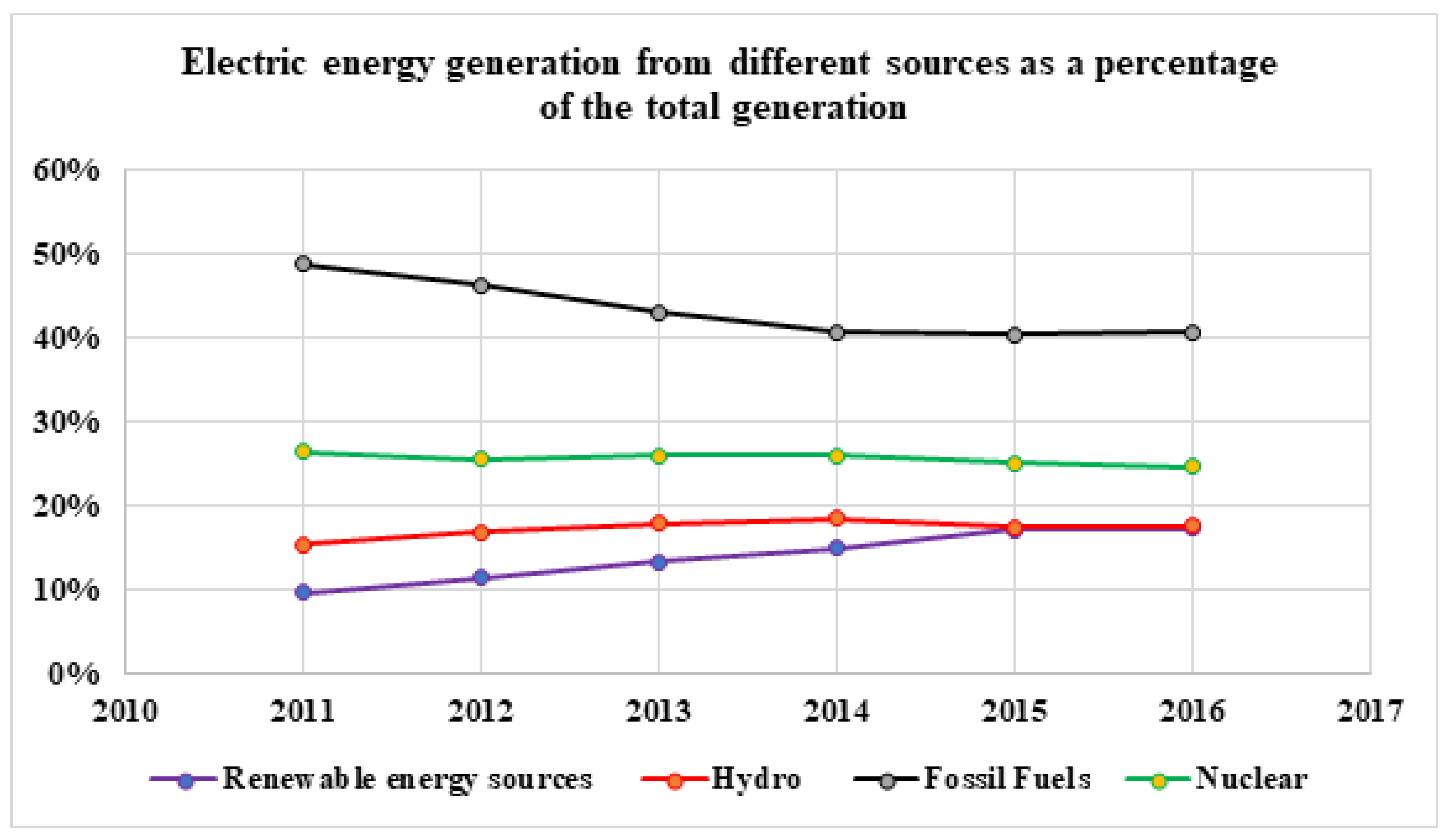
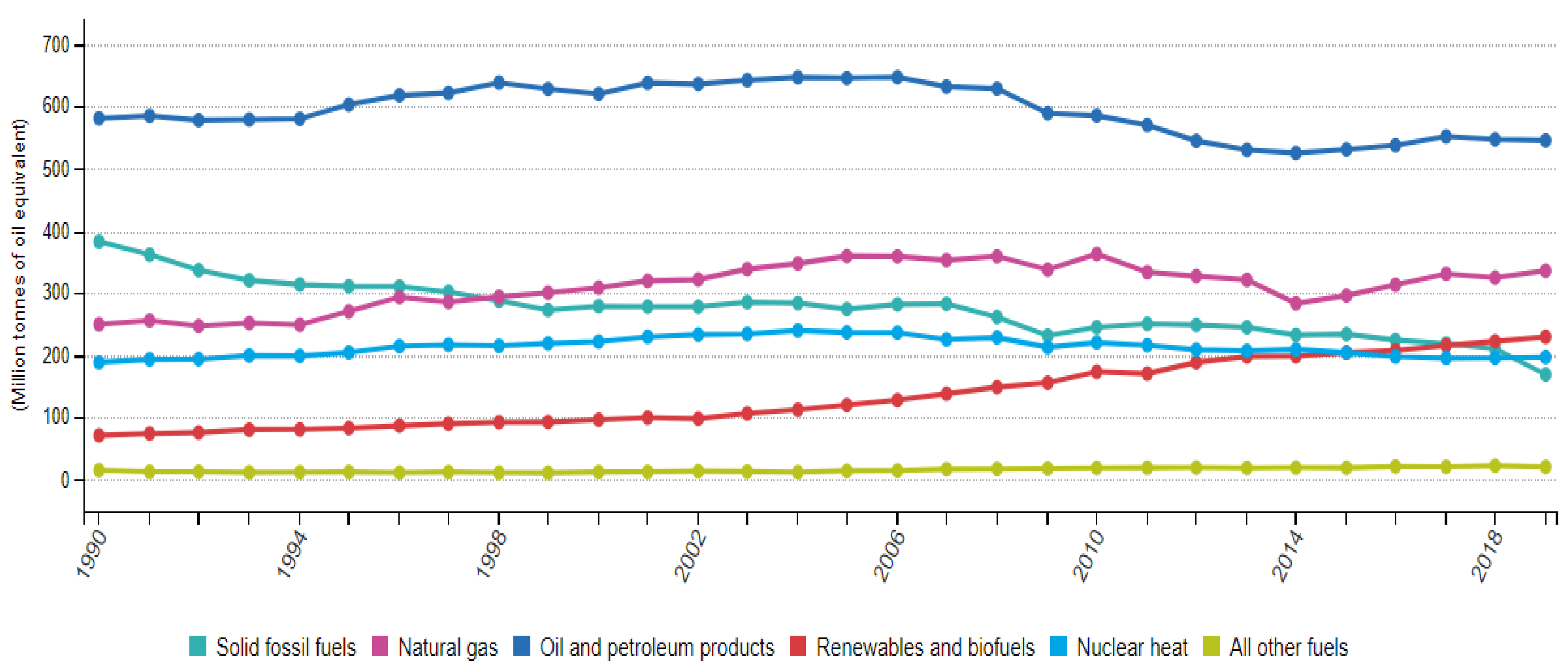
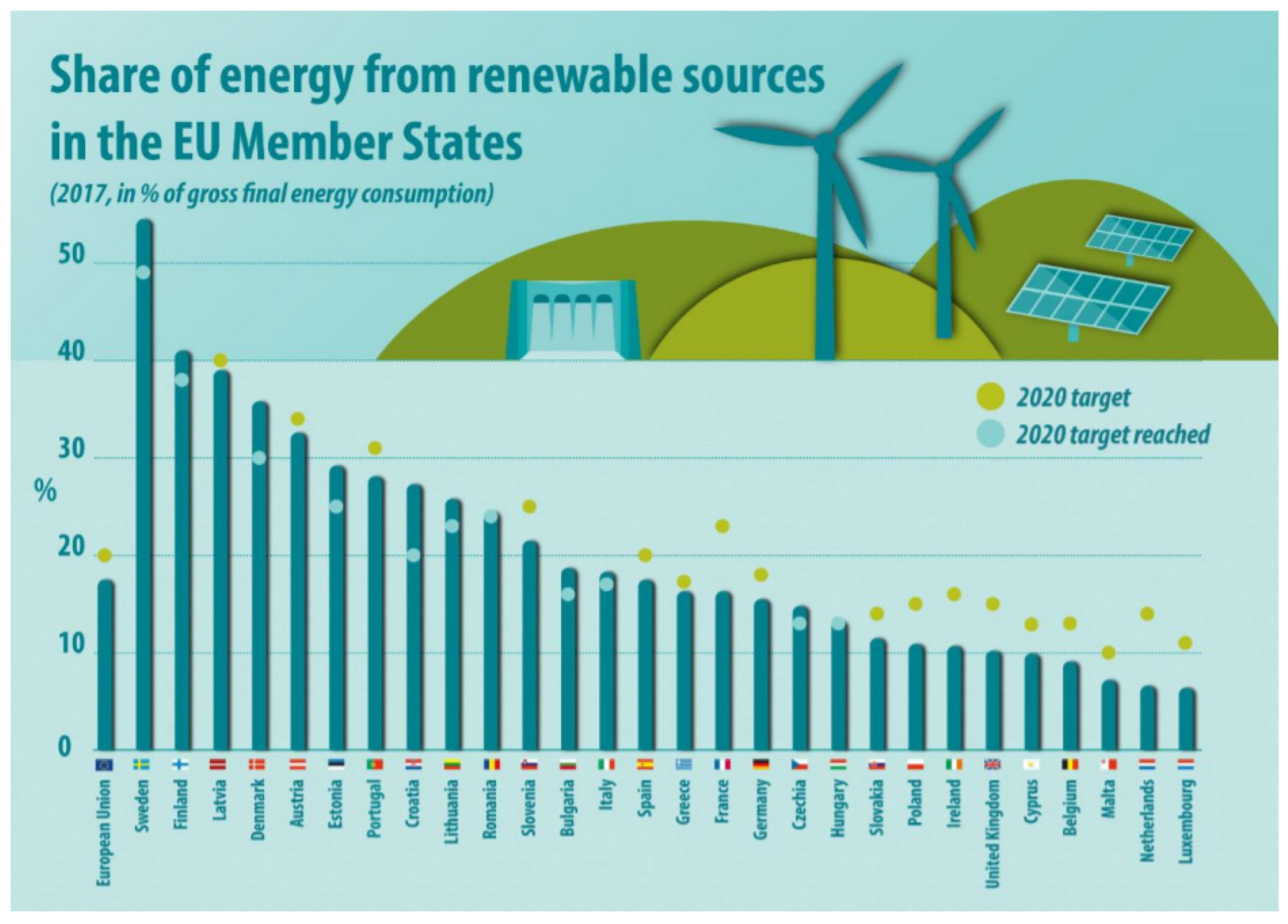

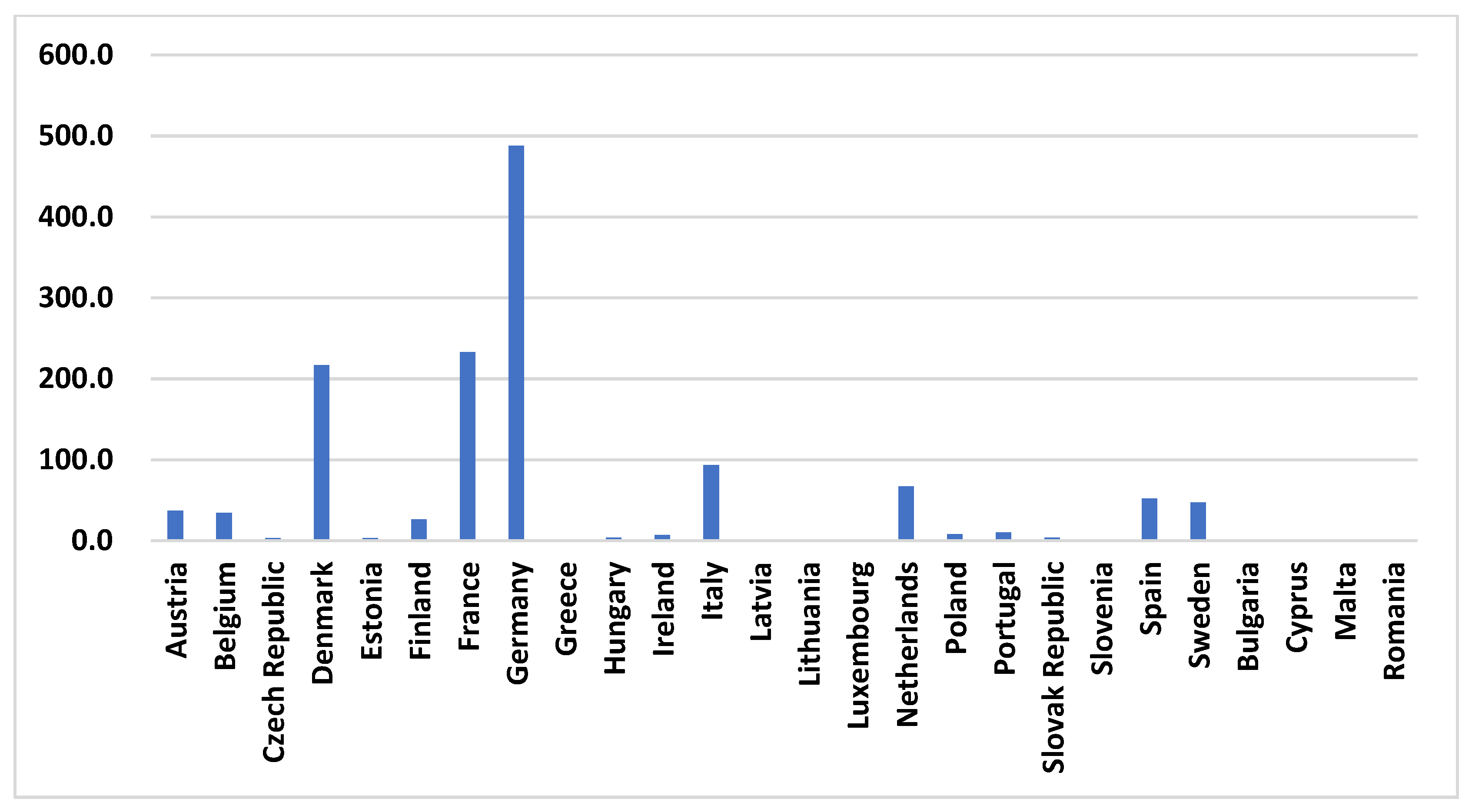
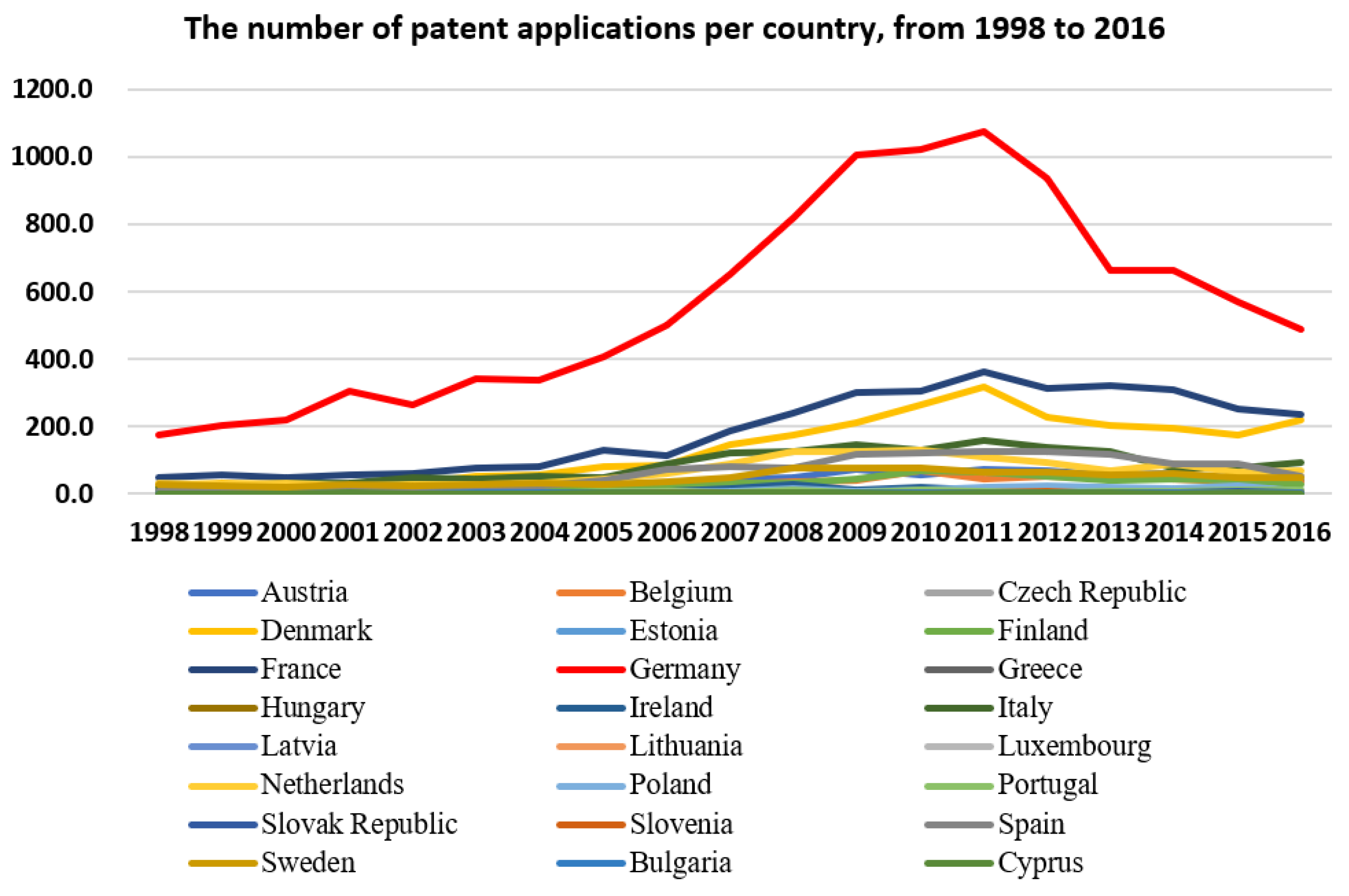
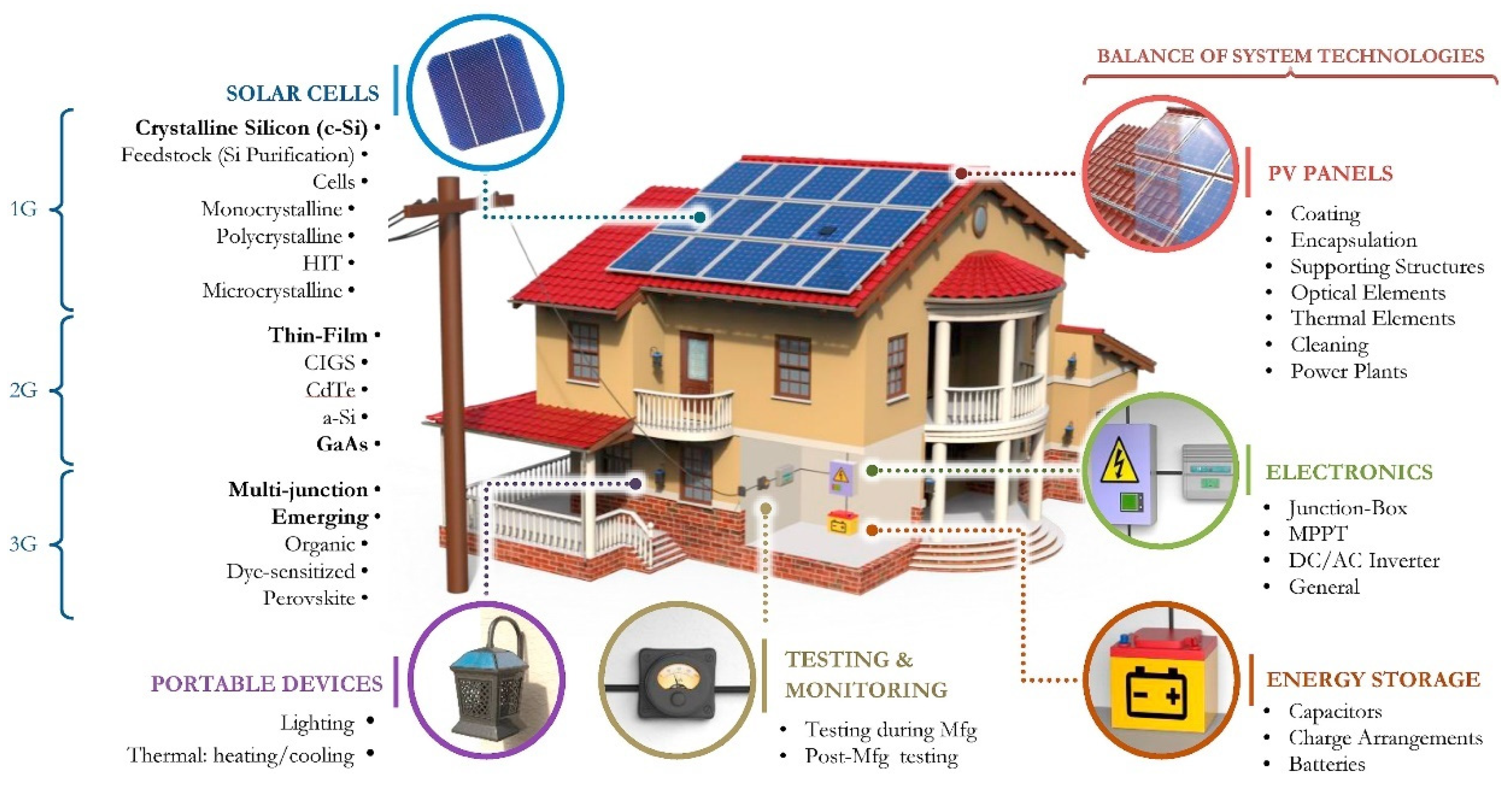
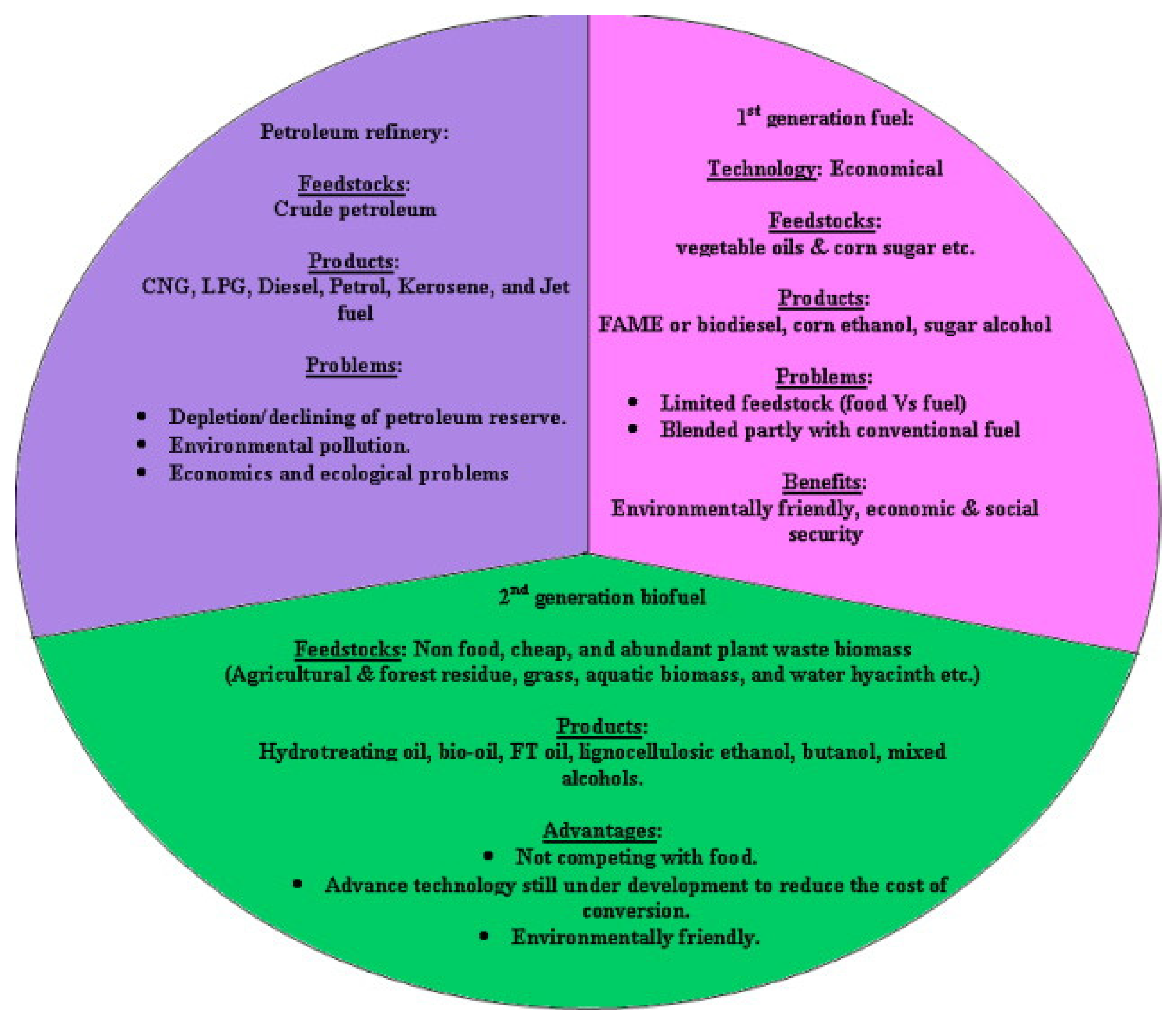
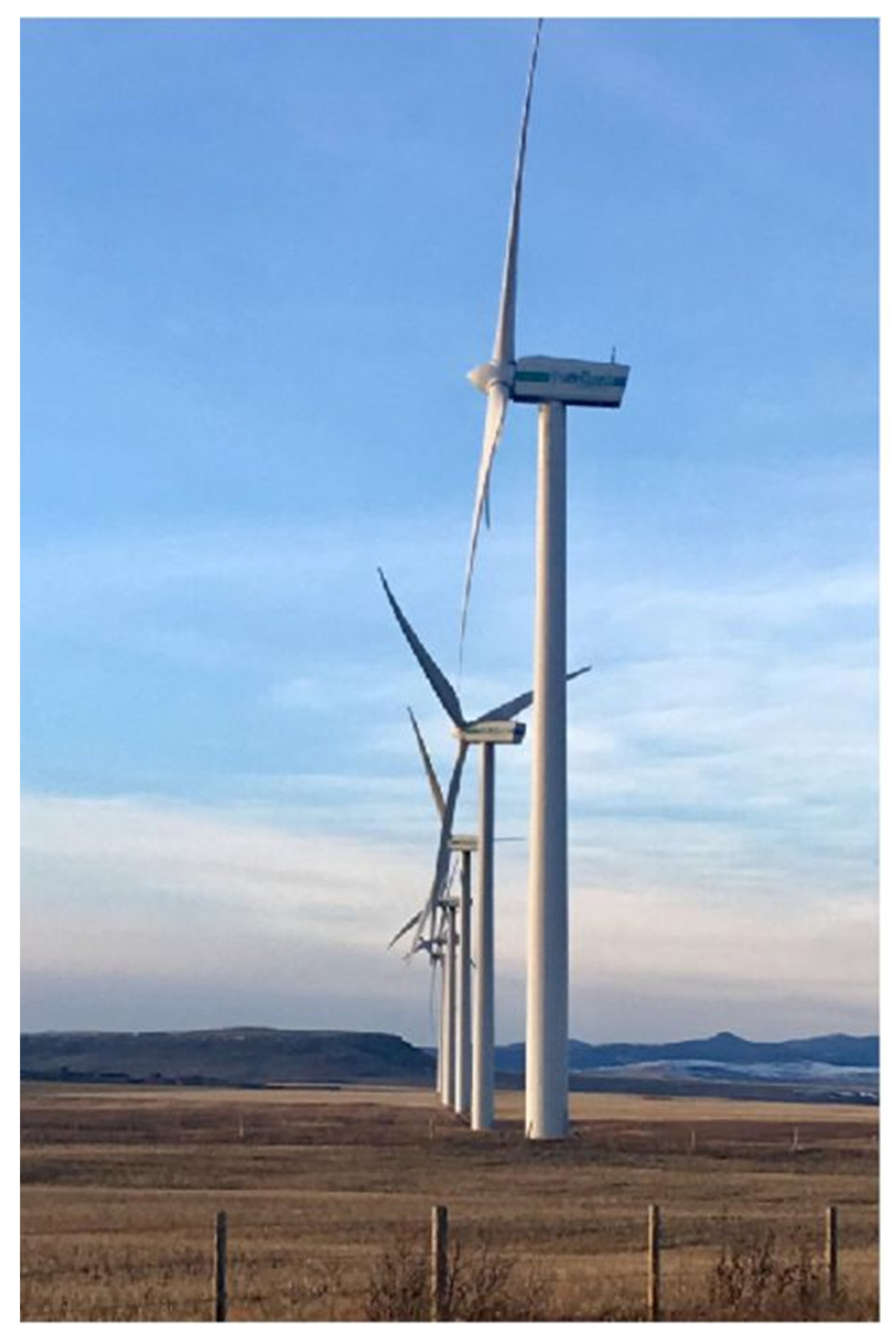
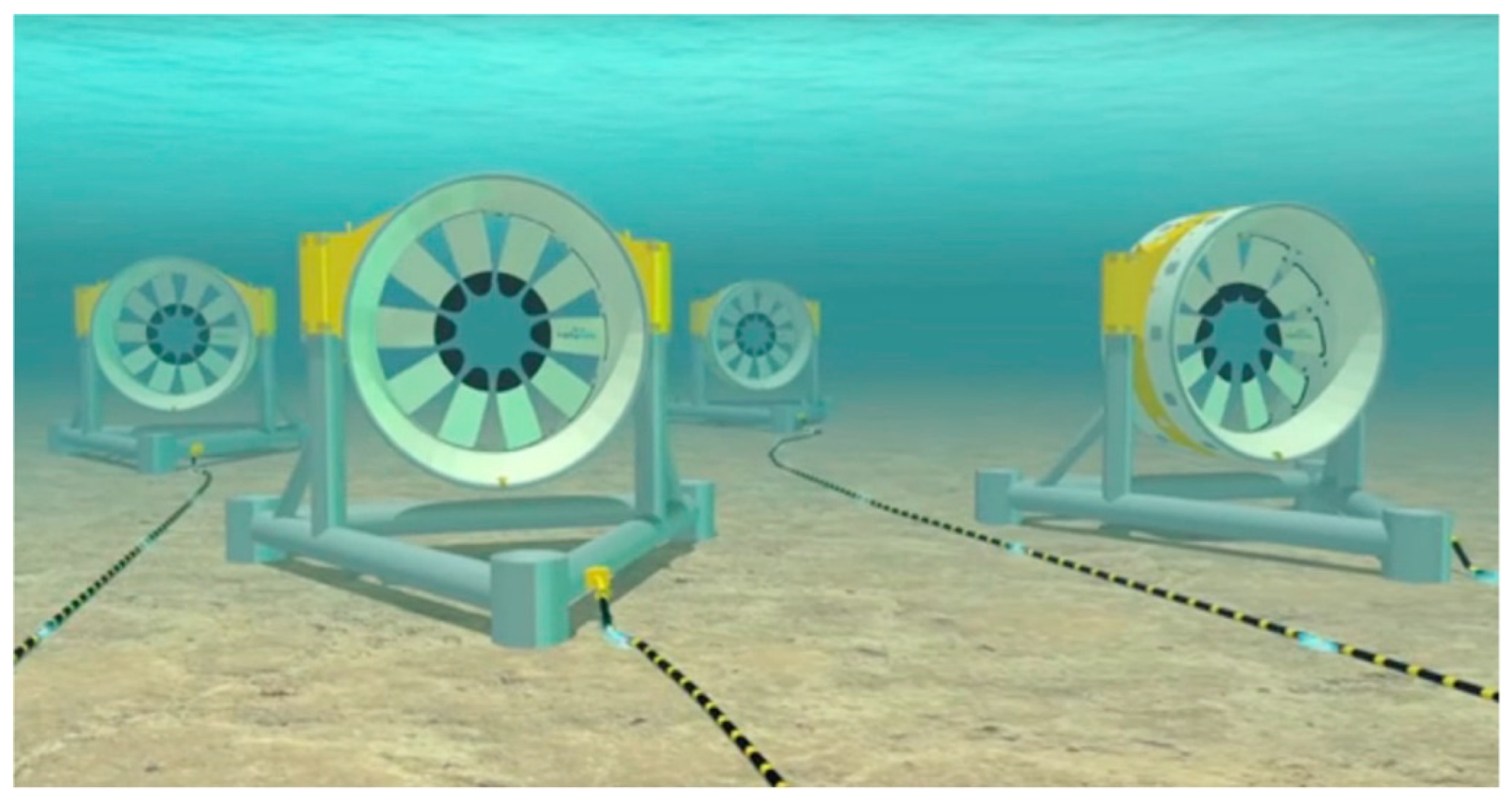
| Electric Energy Source/Year | 2011 | 2012 | 2013 | 2014 | 2015 | 2016 |
|---|---|---|---|---|---|---|
| Renewable Energy Sources (TWh) | 323 | 382 | 438 | 495 | 572 | 573 |
| Nuclear (TWh) | 887 | 862 | 857 | 859 | 836 | 817 |
| Fossil Fuels (TWh) | 1641 | 1562 | 1420 | 1344 | 1345 | 1354 |
| Hydro (TWh) | 517 | 567 | 590 | 613 | 578 | 583 |
| Variables | Renewable |
|---|---|
| Natural log of GDP | 7.474 *** |
| [0.350] | |
| Patents per GDP | 9409.304 *** |
| [1362.909] | |
| Constant | −80.148 *** |
| [4.232] | |
| Observations | 494 |
| Number of Countries | 26 |
| R-squared | 0.577 |
Publisher’s Note: MDPI stays neutral with regard to jurisdictional claims in published maps and institutional affiliations. |
© 2022 by the authors. Licensee MDPI, Basel, Switzerland. This article is an open access article distributed under the terms and conditions of the Creative Commons Attribution (CC BY) license (https://creativecommons.org/licenses/by/4.0/).
Share and Cite
Kulkarni, S.S.; Wang, L.; Venetsanos, D. Managing Technology Transfer Challenges in the Renewable Energy Sector within the European Union. Wind 2022, 2, 150-174. https://doi.org/10.3390/wind2010009
Kulkarni SS, Wang L, Venetsanos D. Managing Technology Transfer Challenges in the Renewable Energy Sector within the European Union. Wind. 2022; 2(1):150-174. https://doi.org/10.3390/wind2010009
Chicago/Turabian StyleKulkarni, Siddharth Suhas, Lin Wang, and Demetrios Venetsanos. 2022. "Managing Technology Transfer Challenges in the Renewable Energy Sector within the European Union" Wind 2, no. 1: 150-174. https://doi.org/10.3390/wind2010009
APA StyleKulkarni, S. S., Wang, L., & Venetsanos, D. (2022). Managing Technology Transfer Challenges in the Renewable Energy Sector within the European Union. Wind, 2(1), 150-174. https://doi.org/10.3390/wind2010009





